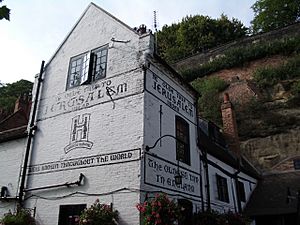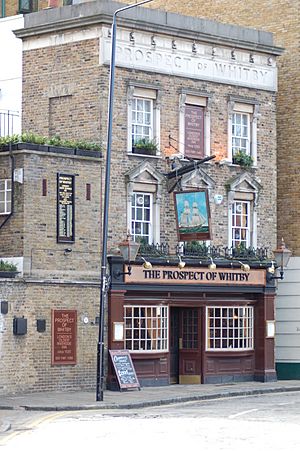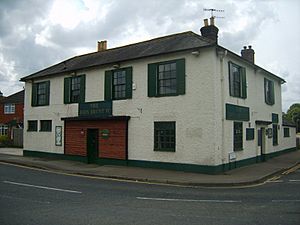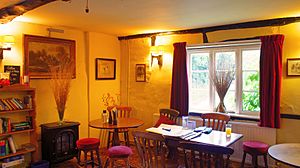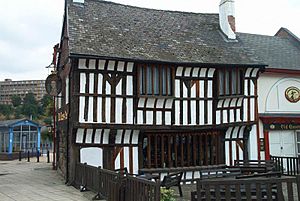List of pubs in the United Kingdom facts for kids
A pub is a special kind of building in the United Kingdom where people can gather, eat, and drink. The word "pub" is short for "public house." These places have been around for hundreds of years and are often important parts of local history. Many pubs are famous for their age, unique stories, or the famous people who visited them. This article lists some of the most interesting pubs in the UK.
Contents
Famous Pubs in England
East Anglia
- The Adam and Eve, Norwich is a very old pub. People think it started in 1249. The building you see today was built in the 1600s.
- The Berney Arms in Norfolk is super unique! You can only get there by walking, by boat, or by train. There are no roads leading to it. It even has its own train station, Berney Arms railway station, which also has no road access.
- The Eagle in Cambridge is famous for science history. In this pub, two scientists, Francis Crick and James Watson, announced they had found the secret to life: the structure of DNA. The ceiling of one room, called 'The RAF Room', is covered with names signed by pilots from World War II.
- The Nutshell, in Bury St Edmunds, Suffolk, is Britain's smallest pub! It's only about 5 meters long and 2 meters wide. That's like a small room! In 1984, 102 people squeezed inside, setting a record.
- The Old Ferryboat Inn in Holywell, Cambridge, is one of many pubs that claim to be the oldest in England. Some say people were gathering there as early as 560 AD!
East Midlands
- Ye Olde Trip to Jerusalem in Nottingham is built into caves under Nottingham Castle. It claims to be the oldest pub in England. People say a model ship hanging from the ceiling is cursed, and the pub is haunted!
- Ye Olde Salutation Inn in Nottingham says it dates back to 1240.
- The Bell Inn in Nottingham has been officially confirmed to be from 1437. It's actually older than the other two Nottingham pubs, though there might have been a brewery at the "Trip" site even earlier.
- The Ram Jam Inn on the A1 in Rutland was named after a story about a famous highwayman. This pub was taken down in late 2022.
London
- The Alchemist, Battersea was a Victorian-era pub. It was taken down without permission in 2015. The people who did it were later told to rebuild it brick-by-brick!
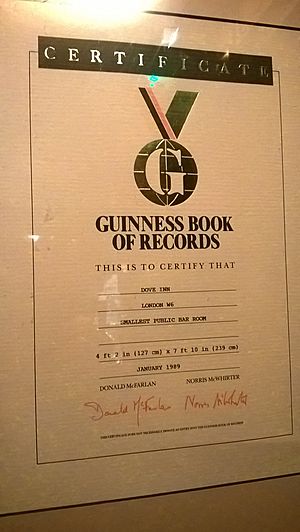
The Dove, Hammersmith, Guinness Book of Records 'Smallest Public Bar Room' Certificate (awarded in 1989)
- The Angel, Islington used to be a place where horse-drawn coaches would stop. The writer Thomas Paine is thought to have written parts of his book The Rights of Man here. It's even on the board in the British version of the game Monopoly!
- The Blind Beggar in Whitechapel is where William Booth, who started the Salvation Army, gave his first speech in 1865.
- The Carlton Tavern in Kilburn was built in 1920. It was also taken down without permission in 2015, and the city council ordered it to be rebuilt brick-by-brick.
- Crocker's Folly in Maida Vale is a huge, fancy Victorian pub. It was built because someone thought a big train station would be built nearby, but it wasn't!
- De Hems, near Shaftesbury Avenue, is London's main Dutch pub. During the Second World War, people from the Dutch resistance met here.
- Dirty Dick's in Bishopsgate was started in 1745. It was rebuilt in 1870.
- The Dove, Hammersmith was a favorite spot for writers like Ernest Hemingway. It claims to have the smallest bar in Britain, according to the Guinness Book of Records.
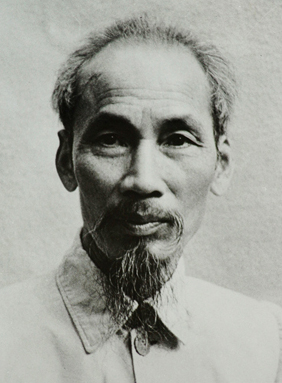
Former Vietnamese leader Ho Chi Minh worked in the kitchen at The Drayton Court in Ealing
- The Drayton Court in Ealing was built in 1893 as a hotel. The former leader of Vietnam, Ho Chi Minh, worked in its kitchens in 1914.
- The George Inn, Southwark is London's only remaining old coaching inn with balconies. It's famous for being visited by Charles Dickens, who wrote about it in his book Little Dorrit.
- The Grapes, Limehouse, on Narrow Street, Limehouse, has been around for over 500 years! It's mentioned in Charles Dickens' novel, Our Mutual Friend. The famous actor Sir Ian McKellen is currently one of its owners.
- The Grenadier in Belgravia was built in 1720 as a place for army officers. It became a pub in 1818. People say it's haunted by a young soldier who was beaten to death after cheating at cards.
- The Lamb, Bloomsbury, on Lamb's Conduit Street, Holborn, is a historic building from the 1720s. It still has its old 'snob screens'. These screens were put up to hide richer people in one part of the bar from common people in another.
- The Old Queens Head, Essex Road, Islington, is said to have been visited by Vladimir Lenin. It's also believed to be haunted by the ghosts of a woman and a girl.
- The Princess Louise in High Holborn is special because its old interior is very well kept and protected.
- The Prospect of Whitby in Wapping is said to be London's oldest riverside pub, dating back to about 1520. It was first called The Devil's Tavern.
- The Sherlock Holmes is a pub on Northumberland Street based on the famous detective Sherlock Holmes. It has many items and memories related to him. It used to be called The Northumberland Arms.
- Spaniards Inn in Hampstead was built in 1585. It's said to be haunted by three ghosts, including the famous highwayman Dick Turpin.
- Sun in the Sands is believed to have been a stopping point for King Henry VIII when he rode from Greenwich.
- The White Hart on the corner of Drury Lane and High Holborn claims to be the oldest licensed pub in London, with records going back to 1216.
- Ye Olde Cheshire Cheese in Fleet Street was rebuilt in 1667 after the Great Fire of London. It's said to have been a favorite place for writers like Samuel Johnson and Charles Dickens.
North East England
- Marsden Grotto is the only pub in Europe built into a sea-cliff face and partially inside sea caves. How cool is that?
North West England
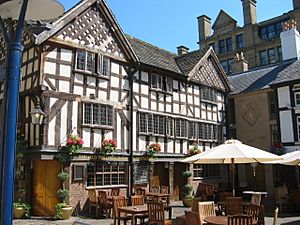
The Old Wellington Inn, Manchester
- The Scotch Piper Inn in Lydiate, Merseyside, is the oldest pub in the traditional county of Lancashire, dating from 1320.
- The Cat and Fiddle Inn in Cheshire is the second-highest pub in England.
- Ye Olde Man and Scythe in Bolton is one of the oldest pubs in the country, dating back to 1251.
- The Moon Under Water in Manchester is the largest pub in the country.
- The Old Wellington Inn in Shambles Square, Manchester is very special. It was the birthplace of a writer named John Byrom. This pub, along with its neighbor, has been physically moved twice! They were lifted up in the 1970s and then taken apart and rebuilt in a new spot after a bombing in 1996.
South East England
- The King's Head in Aylesbury is a medieval inn. It's one of about 30 pubs in England run by the National Trust, which protects historic places.
- The Hand & Flowers in Marlow is a famous gastropub (a pub known for its high-quality food). It was the first pub in the UK to earn two Michelin stars for its food!
- The John Brunt V.C. in Paddock Wood, Kent, is one of only three pubs in the country named after someone who won the Victoria Cross, a very brave award.
- Ye Olde Fighting Cocks in St Albans, Hertfordshire, also claims to be the oldest pub in Britain.
South West England
- Jamaica Inn in Bolventor, Cornwall, is famous because it's the setting for a 1936 novel by Daphne du Maurier. This book was even made into a film by Alfred Hitchcock!
- The Warren House Inn is a very remote pub in the middle of Dartmoor, Devon. It's the highest pub in southern England, sitting at 434 meters (1,425 feet) above sea level.
- The George Inn, Norton St Philip, Somerset, was built in the 1300s or 1400s. It was once used as an army headquarters and a courtroom.
- Bristol
- The Black Castle Public House in Brislington looks like a castle! It was built between 1745 and 1755 as a decorative "sham castle" using black blocks.
- The Llandoger Trow on King Street, dating from 1664, is said to be the inspiration for the Admiral Benbow pub in the famous book Treasure Island.
- The Old Duke on King Street is a popular place for Jazz and Blues music. It was originally named The Duke of Cumberland, but its name was changed to honor the jazz musician Duke Ellington.
- The Pump House in the Hotwells area was built around 1870 to power bridges and machines in Bristol Harbour. Now, it's a gastropub.
- The Seven Stars in Redcliffe is strongly connected to Thomas Clarkson, who worked to end slavery.
Southern England
- The Bat & Ball Inn in Clanfield, Hampshire, is a 17th-century inn right next to the 'Cradle of Cricket', where the game of cricket is said to have started.
- The Bell Inn at Aldworth in Berkshire is a 15th-century inn that has won the National Pub of the Year award twice!
- The Bear Inn, Oxford is said to be Oxford's oldest pub, dating back to 1242. It also has a huge collection of ties!
- The Eagle and Child in Oxford is famous for being a meeting place for "The Inklings," a group of writers that included J. R. R. Tolkien (who wrote The Lord of the Rings) and C. S. Lewis (who wrote The Chronicles of Narnia).
- The Red Lion Inn, Southampton is a very old pub from 1148. King Henry V is said to have tried people accused of treason here in 1415, just before he left for France.
West Midlands
- The Crooked House (also called The Glynne Arms) near Dudley, Staffordshire, was very unusual. It got its name because it tilted at a 15-degree angle due to the ground sinking from mining! It has now been taken down.
- The Dirty Duck in Stratford-upon-Avon has been a pub since 1738. Actors from the nearby Royal Shakespeare Company often visit it. You can see photos inside of famous visitors like Judi Dench and Richard Burton.
- The Old Crown in Birmingham is one of the oldest buildings in the city and the oldest pub, dating back to 1368.
Yorkshire
- The Bingley Arms claims to be the oldest recorded inn in Britain. It's in the small village of Bardsey, West Yorkshire.
- The Kelham Island Tavern in Sheffield is the only pub to have won a national pub award twice in a row!
- The Old Queen's Head in Sheffield opened as a pub in the mid-1800s, but the building itself is much older, from around 1475. People think the "Queen" in its name might be Mary, Queen of Scots, who was held in Sheffield for many years.
- The Tan Hill Inn in Yorkshire is the highest inn in England, at 528 meters (1,732 feet) above sea level.
Famous Pubs in Wales
- Abbey Hotel, Llanthony Priory, Monmouthshire, is a historic country inn and hotel.
- Albion Ale House, Conwy, is a 1920s pub that has won awards for being a great pub and for keeping its historic look.
- The Blue Anchor Inn, Aberthaw, Vale of Glamorgan, is a thatched pub from the 1300s.
- The Vulcan in Cardiff was built in 1853 and was Cardiff's oldest pub under its original name. It was taken apart in 2012 to be rebuilt at a history museum.
- Black Boy Inn, in Caernarfon, is a hotel and pub thought to date back to 1522.
Images for kids

All content from Kiddle encyclopedia articles (including the article images and facts) can be freely used under Attribution-ShareAlike license, unless stated otherwise. Cite this article:
List of pubs in the United Kingdom Facts for Kids. Kiddle Encyclopedia.


